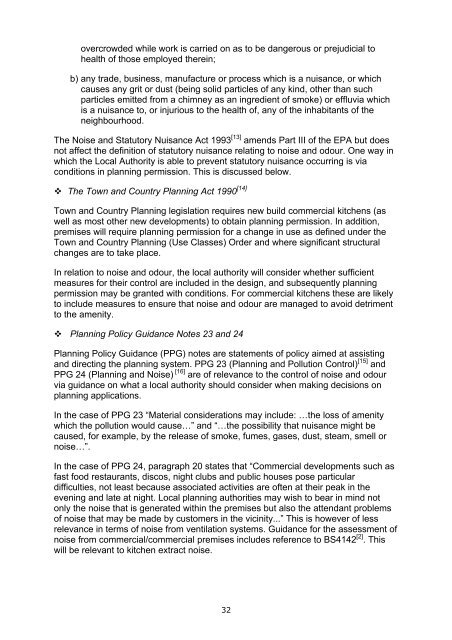Guidance on the Control of Odour and Noise from ... - Defra
Guidance on the Control of Odour and Noise from ... - Defra
Guidance on the Control of Odour and Noise from ... - Defra
Create successful ePaper yourself
Turn your PDF publications into a flip-book with our unique Google optimized e-Paper software.
overcrowded while work is carried <strong>on</strong> as to be dangerous or prejudicial to<br />
health <strong>of</strong> those employed <strong>the</strong>rein;<br />
b) any trade, business, manufacture or process which is a nuisance, or which<br />
causes any grit or dust (being solid particles <strong>of</strong> any kind, o<strong>the</strong>r than such<br />
particles emitted <strong>from</strong> a chimney as an ingredient <strong>of</strong> smoke) or effluvia which<br />
is a nuisance to, or injurious to <strong>the</strong> health <strong>of</strong>, any <strong>of</strong> <strong>the</strong> inhabitants <strong>of</strong> <strong>the</strong><br />
neighbourhood.<br />
The <strong>Noise</strong> <strong>and</strong> Statutory Nuisance Act 1993 [13] amends Part III <strong>of</strong> <strong>the</strong> EPA but does<br />
not affect <strong>the</strong> definiti<strong>on</strong> <strong>of</strong> statutory nuisance relating to noise <strong>and</strong> odour. One way in<br />
which <strong>the</strong> Local Authority is able to prevent statutory nuisance occurring is via<br />
c<strong>on</strong>diti<strong>on</strong>s in planning permissi<strong>on</strong>. This is discussed below.<br />
� The Town <strong>and</strong> Country Planning Act 1990 [14]<br />
Town <strong>and</strong> Country Planning legislati<strong>on</strong> requires new build commercial kitchens (as<br />
well as most o<strong>the</strong>r new developments) to obtain planning permissi<strong>on</strong>. In additi<strong>on</strong>,<br />
premises will require planning permissi<strong>on</strong> for a change in use as defined under <strong>the</strong><br />
Town <strong>and</strong> Country Planning (Use Classes) Order <strong>and</strong> where significant structural<br />
changes are to take place.<br />
In relati<strong>on</strong> to noise <strong>and</strong> odour, <strong>the</strong> local authority will c<strong>on</strong>sider whe<strong>the</strong>r sufficient<br />
measures for <strong>the</strong>ir c<strong>on</strong>trol are included in <strong>the</strong> design, <strong>and</strong> subsequently planning<br />
permissi<strong>on</strong> may be granted with c<strong>on</strong>diti<strong>on</strong>s. For commercial kitchens <strong>the</strong>se are likely<br />
to include measures to ensure that noise <strong>and</strong> odour are managed to avoid detriment<br />
to <strong>the</strong> amenity.<br />
� Planning Policy <str<strong>on</strong>g>Guidance</str<strong>on</strong>g> Notes 23 <strong>and</strong> 24<br />
Planning Policy <str<strong>on</strong>g>Guidance</str<strong>on</strong>g> (PPG) notes are statements <strong>of</strong> policy aimed at assisting<br />
<strong>and</strong> directing <strong>the</strong> planning system. PPG 23 (Planning <strong>and</strong> Polluti<strong>on</strong> C<strong>on</strong>trol) [15] <strong>and</strong><br />
PPG 24 (Planning <strong>and</strong> <strong>Noise</strong>) [16] are <strong>of</strong> relevance to <strong>the</strong> c<strong>on</strong>trol <strong>of</strong> noise <strong>and</strong> odour<br />
via guidance <strong>on</strong> what a local authority should c<strong>on</strong>sider when making decisi<strong>on</strong>s <strong>on</strong><br />
planning applicati<strong>on</strong>s.<br />
In <strong>the</strong> case <strong>of</strong> PPG 23 “Material c<strong>on</strong>siderati<strong>on</strong>s may include: …<strong>the</strong> loss <strong>of</strong> amenity<br />
which <strong>the</strong> polluti<strong>on</strong> would cause…” <strong>and</strong> “…<strong>the</strong> possibility that nuisance might be<br />
caused, for example, by <strong>the</strong> release <strong>of</strong> smoke, fumes, gases, dust, steam, smell or<br />
noise…”.<br />
In <strong>the</strong> case <strong>of</strong> PPG 24, paragraph 20 states that “Commercial developments such as<br />
fast food restaurants, discos, night clubs <strong>and</strong> public houses pose particular<br />
difficulties, not least because associated activities are <strong>of</strong>ten at <strong>the</strong>ir peak in <strong>the</strong><br />
evening <strong>and</strong> late at night. Local planning authorities may wish to bear in mind not<br />
<strong>on</strong>ly <strong>the</strong> noise that is generated within <strong>the</strong> premises but also <strong>the</strong> attendant problems<br />
<strong>of</strong> noise that may be made by customers in <strong>the</strong> vicinity...” This is however <strong>of</strong> less<br />
relevance in terms <strong>of</strong> noise <strong>from</strong> ventilati<strong>on</strong> systems. <str<strong>on</strong>g>Guidance</str<strong>on</strong>g> for <strong>the</strong> assessment <strong>of</strong><br />
noise <strong>from</strong> commercial/commercial premises includes reference to BS4142 [2] . This<br />
will be relevant to kitchen extract noise.<br />
32
















